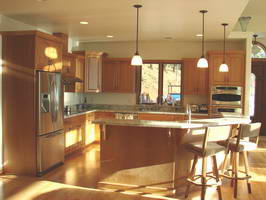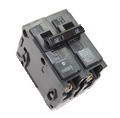Remodeling a Bathroom with GFI Outlet and Lights
 '; ';
|
How is a bathroom wired with GFCI outlets and light fixtures? Home Electrical Wiring for a Bathroom Remodel Project. © By: Dave Rongey |
Bathroom Remodel
Electrical Project: How is a bathroom wired with GFCI outlets and light fixtures?
- I’m in the middle of a bathroom remodel and (as expected) some surprises cropped up when it came to wiring. We have taken the walls and ceiling down to the studs, so there’s a lot of room to play with.
- First, the easy one. Circuit breaker 11 is a 15A breaker. Previously it ran to two lights and a receptacle in the bathroom. My new plan is to have it feed five bathroom lights (60W), two vanity lights (75W) and one vent fan (draws 0.6A).
- Breaker 11 also feeds the hallway light, dining room light, guest bedroom light and three receptacles in the guest bedroom. But I believe if my calculations are right, a 15A breaker should be fine with this, right? All wires on this circuit are 14/2.
- It took a while to discover this, but there is a set of breakers (22 and 24) wired in parallel with each other, effectively making a 35 amp breaker (one 15A and one 20A). This feeds the fridge in the kitchen, as well as four receptacles in the kitchen area (one of which is on the opposite side of a bathroom wall).
- I planned to use this circuit to feed two more outlets in the bathroom – both GFCI. But this circuit for some reason I can’t fathom has 3 wire cable (red, black, white). I can’t find a double pole GFCI receptacle anywhere, so my plan is to split off 10/2 cable (black and white) to each GFCI outlet. I’ll then plan to just daisy-chain the red wire along to the rest of the circuit (since my GFCI outlets will be in the middle of the circuit). Is this a good plan?
- One I’m most nervous about. I’m not sure of the gauge on the existing circuit that runs through breakers 22 and 24, but I’m concerned it’s not a thick enough wire. I changed the breakers so there are now two 15A instead of a 15A and 20A (effectively making a 30A circuit). That way, I’m sure my 10/2 wire is safe for the GFCI’s. But is the wiring safe for the rest of the home, or do I need to replace it?
- The house is not huge (2800 sq ft, ranch style), and the furthest outlet is about 2/3rds of the way down the house from the breaker box, so shouldn’t be a huge distance issue.
Happy to provide more info if needed – hopefully all this makes sense.
Thanks so much for your help!
This electrical question came from: Chris in Michigan.
Dave’s Reply:
Thanks for your electrical wiring question Chris.
Wow, this is a great Bathroom Remodel project Chris, please see the information below to help answer your electrical wiring questions.
Electrical Wiring for a Bathroom Remodel Project
- Application: Installing Bathroom Electrical Wiring.
- Skill Level: Intermediate to Advanced. This electrical wiring project is best performed by a Licensed Electrical Contractor or Certified Electrician.
- Tools Required: Electricians Pouch of Hand Tools for Rough-In Wiring, Electric Drill and Auger Bits and Extension Cord.
- Estimated Time: Depends on the extent of the bathroom remodel project, the type of construction and available access to the project area.
- Precaution: Any existing wiring in the immediate area that may interfere with the installation of new construction materials should be identified, turned OFF and Tagged.
- Notice: Modifying existing wiring or installing additional bathroom electrical wiring should be done according to local and national electrical codes with a permit and be inspected.
Bathroom Electrical Circuit Wiring
- The bathroom receptacle outlet should be on a dedicated 20 amp circuit and the bathroom vanity light may be on a shared circuit.
- The following resources will give you access to wiring diagrams and answer your electrical questions.
More about Bathroom Electrical Wiring
How to Install Bathroom Electrical Wiring
Bathroom Electrical Wiring
- Fully Explained Photos and Wiring Diagrams for Bathroom Electrical Wiring with Code Requirements for most new or remodel projects.
Electrical Circuit Wiring
This article looks at common 120 volt and 240 volt house wiring circuits and the circuit breakers that are installed identifying the types and amperage sizes used in most homes.
Electrical Panel Circuit Listing
Home Electrical Circuit Breakers
A guide to home electrical circuit breakers and how they work to protect your electrical wiring. When properly installed, your home electrical wiring is protected by a circuit protection device.
GFCI and GFI Wiring Diagrams
The features and benefits of GFCI outlets and receptacles will give you a clear understanding of the importance why these safety devices are required by code to help protect you and your family against accidental electrical shock hazards.
GFCI Wiring
This list of articles will help you learn about the features and benefits provided by GFI and GFCI Receptacles and how they are wired.
The following may also be helpful for you:
Be Careful and Be Safe - Never Work on Energized Circuits!
Consult your Local Building Department about Permits and Inspections for all Electric Wiring Projects.
More articles about Bathroom Electrical, Electrical Wiring and Home Electrical Wiring: |
|
| « Previous | Next » |
Repair a Tripping GFCI Outlet |
Why Does My Electric Motor Humm And Not Start? |














